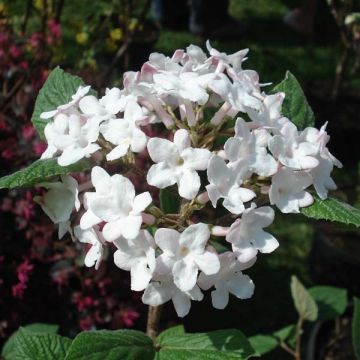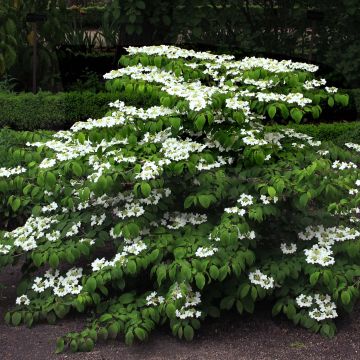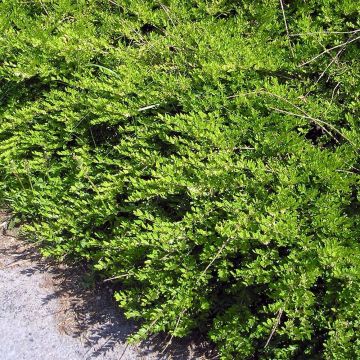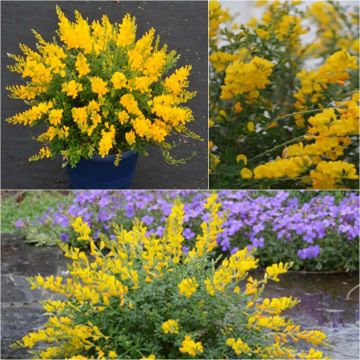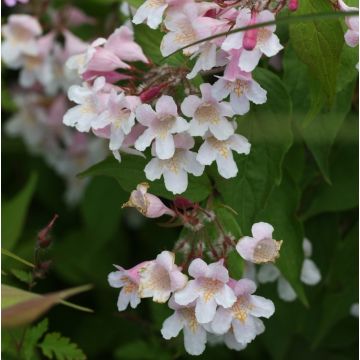

Viburnum nudum Pink Beauty


Viburnum nudum Pink Beauty
Viburnum nudum Pink Beauty
Viburnum nudum Pink Beauty
Possumhaw Viburnum, Smooth Witherod, Naked Witherod
Ordered in 2020, it does not produce the berries indicated in the description, and it does not have the characteristic glossy foliage of this variety. Moreover, the flowers are also different. In conclusion, you have probably sent me a viburnum, but not the right one... frustrating!
Cecile, 09/05/2022
This item cannot be shipped to the selected country
Delivery charge from €5.90
More information
Schedule delivery date,
and select date in basket
This plant carries a 24 months recovery warranty
More information
We guarantee the quality of our plants for a full growing cycle, and will replace at our expense any plant that fails to recover under normal climatic and planting conditions.
From €5.90 for pickup delivery and €6.90 for home delivery
Express home delivery from €8.90.
Does this plant fit my garden?
Set up your Plantfit profile →
Description
Viburnum nudum 'Pink Beauty' is a charming variety of naked viburnum, attractive almost all year round. This shrub captivates with its adorable little pink and then violet berries that persist on the branches for a long time in winter, its often semi-evergreen foliage with splendid autumn colours, but also with its somewhat Japanese-inspired habit, supported by tiered branches. With a moderate growth, both rustic, refined and colourful, 'Pink Beauty' is also an easy plant to grow in any good garden soil that is not too dry.
The pedunculate cymes viburnum, often called naked viburnum, is a shrub native to China. It now belongs to the Adoxaceae family, formerly part of the Caprifoliaceae family. The cultivar 'Pink Beauty', obtained in the USA, stands out for its compact habit, but above all for its remarkable pink and violet fruiting. This shrub will not exceed 2m (6ft 5in) in height and 1.5m (4ft 11in) in width. Its habit is generally upright, but the shrub develops in tiers, through spreading secondary branches. It blooms in June-July, in the form of large flat corymbs, 10 to 15cm (3.9 - 5.9in) in diameter; they are composed of small white flowers, sometimes pink. This slightly fragrant flowering is very melliferous and nectariferous. The fruiting is abundant and very decorative, in the form of clusters where numerous round berries of a very bright pink are packed with ripe berries that have turned violet. Its foliage, deciduous to semi-evergreen depending on the severity of the winter, is composed of large elliptical leaves of a beautiful shiny dark green. They turn red, purple-violet, and brown in autumn.
Completely hardy, 'Pink Beauty' naked viburnum is an undemanding plant. It thrives in sunny or semi-shady positions, and flourishes in any ordinary soil that is rather moist, even slightly calcareous. It can be used as a focal point to attract attention in small gardens, in pots on a terrace, in hedges or in borders in larger gardens. In a hedge, it can be associated with a variety of shrubs chosen for their autumn foliage (Euonymus europaeus, Euonymus alatus, Cotinus, Oakleaf Hydrangea, Physocarpus), their spring flowering (mock orange, Deutzia, lilac, Canadian serviceberry), or for their attractive fruiting (chokeberries, beautyberries, snowberries, Chinese quince...). Its graceful inflorescences can be included in your spring bouquets and its fruit clusters will decorate festive tables in winter.
Report an error about the product description
Viburnum nudum Pink Beauty in pictures


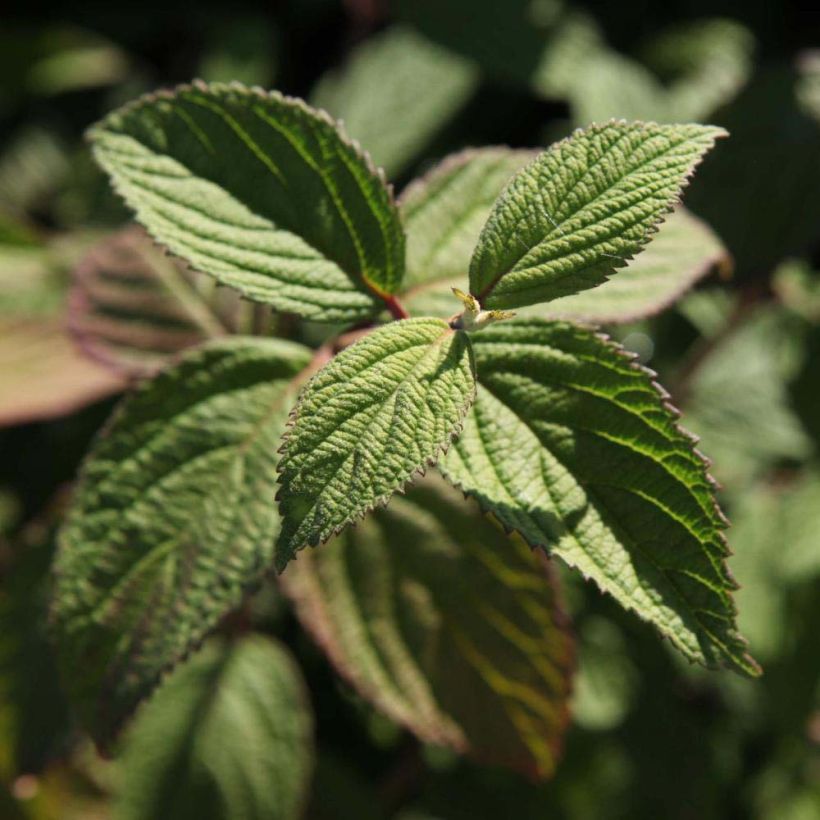

Plant habit
Flowering
Foliage
Botanical data
Viburnum
nudum
Pink Beauty
Caprifoliaceae (Adoxaceae)
Possumhaw Viburnum, Smooth Witherod, Naked Witherod
Cultivar or hybrid
Other Viburnum
Planting and care
Viburnum nudum 'Pink Beauty' thrives in sunny or semi-shade positions. While it prefers a moist, humus-rich and light soil, it adapts to any good garden soil that is not too dry, even slightly chalky. If the soil is very chalky, you can add heather soil to the planting substrate. Adequate watering after planting and during the first few weeks will ensure good establishment. Light pruning can be done after flowering to maintain a compact habit, but this will naturally reduce fruit production.
Planting period
Intended location
Care
-
, onOrder confirmed
Reply from on Promesse de fleurs
Hedge shrubs
Haven't found what you were looking for?
Hardiness is the lowest winter temperature a plant can endure without suffering serious damage or even dying. However, hardiness is affected by location (a sheltered area, such as a patio), protection (winter cover) and soil type (hardiness is improved by well-drained soil).

Photo Sharing Terms & Conditions
In order to encourage gardeners to interact and share their experiences, Promesse de fleurs offers various media enabling content to be uploaded onto its Site - in particular via the ‘Photo sharing’ module.
The User agrees to refrain from:
- Posting any content that is illegal, prejudicial, insulting, racist, inciteful to hatred, revisionist, contrary to public decency, that infringes on privacy or on the privacy rights of third parties, in particular the publicity rights of persons and goods, intellectual property rights, or the right to privacy.
- Submitting content on behalf of a third party;
- Impersonate the identity of a third party and/or publish any personal information about a third party;
In general, the User undertakes to refrain from any unethical behaviour.
All Content (in particular text, comments, files, images, photos, videos, creative works, etc.), which may be subject to property or intellectual property rights, image or other private rights, shall remain the property of the User, subject to the limited rights granted by the terms of the licence granted by Promesse de fleurs as stated below. Users are at liberty to publish or not to publish such Content on the Site, notably via the ‘Photo Sharing’ facility, and accept that this Content shall be made public and freely accessible, notably on the Internet.
Users further acknowledge, undertake to have ,and guarantee that they hold all necessary rights and permissions to publish such material on the Site, in particular with regard to the legislation in force pertaining to any privacy, property, intellectual property, image, or contractual rights, or rights of any other nature. By publishing such Content on the Site, Users acknowledge accepting full liability as publishers of the Content within the meaning of the law, and grant Promesse de fleurs, free of charge, an inclusive, worldwide licence for the said Content for the entire duration of its publication, including all reproduction, representation, up/downloading, displaying, performing, transmission, and storage rights.
Users also grant permission for their name to be linked to the Content and accept that this link may not always be made available.
By engaging in posting material, Users consent to their Content becoming automatically accessible on the Internet, in particular on other sites and/or blogs and/or web pages of the Promesse de fleurs site, including in particular social pages and the Promesse de fleurs catalogue.
Users may secure the removal of entrusted content free of charge by issuing a simple request via our contact form.
The flowering period indicated on our website applies to countries and regions located in USDA zone 8 (France, the United Kingdom, Ireland, the Netherlands, etc.)
It will vary according to where you live:
- In zones 9 to 10 (Italy, Spain, Greece, etc.), flowering will occur about 2 to 4 weeks earlier.
- In zones 6 to 7 (Germany, Poland, Slovenia, and lower mountainous regions), flowering will be delayed by 2 to 3 weeks.
- In zone 5 (Central Europe, Scandinavia), blooming will be delayed by 3 to 5 weeks.
In temperate climates, pruning of spring-flowering shrubs (forsythia, spireas, etc.) should be done just after flowering.
Pruning of summer-flowering shrubs (Indian Lilac, Perovskia, etc.) can be done in winter or spring.
In cold regions as well as with frost-sensitive plants, avoid pruning too early when severe frosts may still occur.
The planting period indicated on our website applies to countries and regions located in USDA zone 8 (France, United Kingdom, Ireland, Netherlands).
It will vary according to where you live:
- In Mediterranean zones (Marseille, Madrid, Milan, etc.), autumn and winter are the best planting periods.
- In continental zones (Strasbourg, Munich, Vienna, etc.), delay planting by 2 to 3 weeks in spring and bring it forward by 2 to 4 weeks in autumn.
- In mountainous regions (the Alps, Pyrenees, Carpathians, etc.), it is best to plant in late spring (May-June) or late summer (August-September).
The harvesting period indicated on our website applies to countries and regions in USDA zone 8 (France, England, Ireland, the Netherlands).
In colder areas (Scandinavia, Poland, Austria...) fruit and vegetable harvests are likely to be delayed by 3-4 weeks.
In warmer areas (Italy, Spain, Greece, etc.), harvesting will probably take place earlier, depending on weather conditions.
The sowing periods indicated on our website apply to countries and regions within USDA Zone 8 (France, UK, Ireland, Netherlands).
In colder areas (Scandinavia, Poland, Austria...), delay any outdoor sowing by 3-4 weeks, or sow under glass.
In warmer climes (Italy, Spain, Greece, etc.), bring outdoor sowing forward by a few weeks.

































